Comets in 2017
Note that Martin wrote this for the (now defunct) 2017 Yearbook of Astronomy and he has generously agreed that it can be used by the BAA.
More than 50 short period comets should be detected approaching perihelion by the professional patrols in 2017, although a few of that number, namely 18D/Perrine-Mrkos, D/Harrington-Wilson (1952 B1) and 5D/Brorsen have been declared defunct and so have a D/ prefix. Essentially, a D/ prefix means that these comets have either run out of volatile material or disintegrated. However, with so many deep surveys now scouring the night sky they may yet be re-discovered. D/Harrington-Wilson (1952 B1) may even be recovered in late 2016 although its perihelion date, if it still exists, would probably be in February or March 2017. All of the short period comets expected to return to perihelion in 2017 orbit the Sun with periods of between 3.3 and 14.9 years and many are too faint for amateur visual observation, even with a large telescope.
Bright or spectacular comets usually have much longer orbital periods and, apart from a few notable exceptions like 1P/Halley, 109P/Swift-Tuttle and 153P/Ikeya-Zhang, the best performers usually have orbital periods of many thousands of years and are often discovered less than a year before they come within amateur range. For this reason it is important to regularly check the best comet websites for news of bright comets that may be discovered well after this Yearbook is finalized. Some recommended sites are:
British Astronomical Association Comet Section: www.britastro.org/comet
Seiichi Yoshida’s bright comet page: www.aerith.net/comet/weekly/current.html
CBAT/MPC comets site: www.minorplanetcenter.net/iau/Ephemerides/Comets/
Yahoo Comet Images group: http://tech.groups.yahoo.com/group/Comet-Images/
Yahoo Comet Mailing list: http://tech.groups.yahoo.com/group/comets-ml/
The CBAT/MPC web page above also gives accurate ephemerides of comet positions in right ascension and declination.
As many as 20 periodic comets might reach a magnitude of fourteen or brighter during 2017 and so they should all be observable with large amateur telescopes equipped with amateur CCD imaging systems, in a reasonably dark sky, from the northern or southern hemispheres. Sadly, only eight or nine comets are, at the time of writing, predicted to reach, or in a few cases exceed, magnitude 11. Therefore, visual targets for large amateur telescopes will be scarce, unless some brighter prospects are discovered in late 2016 or 2017. In recent years the amateur astronomer Terry Lovejoy from Queensland, Australia, has discovered some splendid comets less than a year from their peak, which the professional patrols have missed, so a binocular magnitude ‘Comet Lovejoy’ in 2017 cannot be ruled out. The current cometary highlights for the coming year are likely to be the returns of 45P/Honda-Mrkos-Pajdusakova, 2P/Encke, 41P/Tuttle-Giacobini-Kresak and 96P/Machholz as well as the relatively new discovery C/2015 V2 (Johnson). Other comets, such as 73P/Schwassmann-Wachmann, 71P/Clark, 62P/Tsuchinshan and 24P/Schaumasse may also provide some cometary entertainment. The distant, usually faint, but regularly outbursting comet 29P/Schwassmann-Wachmann is bound to provide a few bouts of activity as well. As is normal with comets, unpredictability is the word, and when combined with the weather, the phase of the Moon, and the trade-off between twilight and low altitudes, every year of the comet observer’s life is very different and often unexpected and frustrating!
It should perhaps be explained that the distances of comets from the Sun and the Earth are often quoted in Astronomical Units (AU) where 1 AU is the average Earth-Sun distance of 149.6 million km or 93 million miles.
The brightest cometary prospects for 2017 are listed below in the order they reach best visibility, which often coincides with reaching perihelion, except when the solar elongation is poor. The first comets in the list reached perihelion at the end of the previous year (2016) and the last in the list reach perihelion next year (2018). The comet 29P/Schwassmann-Wachmann is two years from its 2019 perihelion date during this year but is best placed on the border region between Capricornus and Aquarius during August, which is why it looks out of place in the table. The perihelion date is largely irrelevant for this comet. This enigmatic object will often be too faint for visual detection, even in large amateur telescopes, but it can rise to eleventh magnitude when in outburst. Despite being, in theory, magnitude 14 or brighter, some returning comets are poorly placed, the very worst example being 103P/Hartley which manages to hug the solar glare for its entire return and so will be unobservable at its best. I have not included it in the list below for that very reason.
Comet Period Perihelion Peak mag.
(Years)
43P/Wolf-Harrington 43P 6.13 2016 Aug. 19 13 in Jan.
45P/Honda-Mrkos-Pajdusakova 5.26 2016 Dec. 31 6 in Jan.
D/1952 B1) (Harrington-Wilson 6.36 Unknown Unknown
93P/Lovas 9.19 2017 March 1 15 in Feb.
2P/Encke 3.30 2017 March 10 5 in March
P/2010 H2 (Vales) 7.53 2017 Sept. 16 13 in March
73P/Schwassmann-Wachmann 5.43 2017 March 16 Fragmented
P/2013 YG46 (Spacewatch) 5.95 2017 Jan. 28 15 in April
41P/Tuttle-Giacobini-Kresak 5.42 2017 April 14 7 in April
C/2015 V2 (Johnson) long 2017 June 11 6 in June
71P/Clark 5.55 2017 June 29 11 in June
65P/Gunn 7.69 2017 Oct. 10 14 in June
29P/Schwassmann-Wachmann 14.7 2019 April 4 11 in outburst
213P/Van Ness 6.17 2017 Sept. 23 12 in Sept.
217P/LINEAR 7.86 2017 July 16 14 in Sept.
P/2004 T1 (LINEAR-NEAT) 6.48 2017 Oct. 13 14 in Oct.
96P/Machholz 5.29 2017 Oct. 27 9 in Oct.
62P/Tsuchinshan 6.38 2017 Nov. 15 11 in Nov.
24P/Schaumasse 8.26 2017 Nov. 16 10 in Nov.
What to expect
The year 2017 could start quite favorably for comet observers if comet 45P/Honda-Mrkos-Pajdusakova lives up to expectations. This regular visitor is heading north and will just have passed perihelion as January begins. It will be painfully low (but a bright magnitude 6) and immersed in the evening UK twilight early in January, but finally rises to a respectable altitude in the morning sky by early February, moving rapidly north and west through Aquila, the north-eastern corner of Ophiuchus, Hercules, Corona Borealis, Boötes, Canes Venatici, Coma Berenices and finally entering Leo, all in the month of February. The magnitude will drop from around 7 to 11 during the month. The reason for the rapid movement of 45P, is the proximity of the comet to the Earth. It is closest, at a mere 0.08426 AU, on Feb 11.26, while in Hercules. The comet will be moving at 22 arc-seconds per minute at that time. 45P comes close to the Earth quite regularly and made 11 close approaches to the Earth in the 20th century alone. The reason for this is its short orbital period of precisely five and a quarter years, as well as its small orbital inclination of just over four degrees. Unfortunately the Moon will be Full on February 11, the day of closest approach.

Figure 1. 45P/Honda-Mrkos-Pajdusakova imaged by the author on 2011 October 1 with a Celestron 14 and two 60 second exposures. The field is 24 arcminutes wide.

Figure 2. 45P/Honda-Mrkos-Pajdusakova moves across Aquila in early February, although at a very low altitude in morning twilight.

Figure 3. 45P/Honda-Mrkos-Pajdusakova moves across Corona Borealis and Boötes in mid-February following its close passage by the Earth.
Comet 2P/Encke is yet another short period comet, with a remarkably small 3.3 year orbital period. For many years this was the smallest period known. As one would expect, every 10 years (three orbits) the observing circumstances from the Earth are roughly the same. As 2017 starts 2P/Encke can be found in western Pisces, as a fourteenth magnitude object close to the star beta Piscium (Fum al Samakah). It moves slowly east through Pisces as it approaches perihelion on March 10, but the field sinks rapidly into the evening twilight glare as February proceeds. With a perihelion distance of only 0.336 AU the comet brightens exponentially as perihelion approaches, but the altitude above the western horizon drops dramatically and the twilight problem increases too. This battle between twilight and altitude is a very common problem for all comet observers. Therefore, perhaps the best time to try and detect 2P/Encke at its best will come in the last weeks of February (the Moon is new on February 26). On February 22 Encke’s motion in front of the background stars will almost halt as it stops moving east and starts to plunge south. On that evening it should be magnitude seven and sit fourteen degrees above the western horizon at 19.00 UT, when the Sun is sixteen degrees down, as seen from southern England. Observers with flat, clear horizons may be able to follow it right up to the end of February, when it will be magnitude 5.5, but as soon as March begins Encke will plunge south. Its solar elongation does not become respectable again until the start of April when it will be in southern Aquarius.
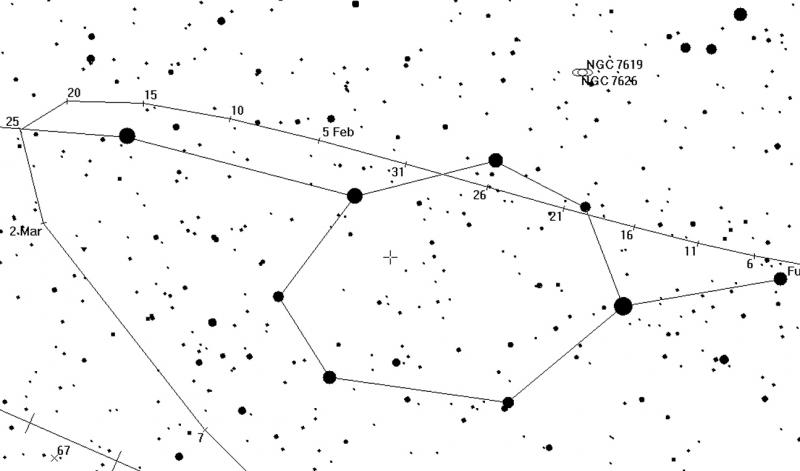
Figure 4. Comet Encke moves east during Pisces in January and February, before plunging south at the start of March, en-route to perihelion.
In addition to Encke a number of other interesting comets will come within the range of experienced amateur astronomers during March and April. The brightest of these should be 41P/Tuttle-Giacobini-Kresak, which reaches perihelion on April 14. From mid-March to mid-May this comet should be a seventh magnitude object, very well placed for UK observers in the far northern regions of the sky. On the evening of March 28 it passes just half a degree below Dubhe, the northernmost pointer star in Ursa Major. Throughout April comet 41P will be superbly positioned, moving from Ursa Major’s northern border with Draco, across Draco (briefly entering Ursa Minor) and moving south into Hercules at the end of the month. Around midnight in early April the comet will be at an altitude of more than 70 degrees from the UK.
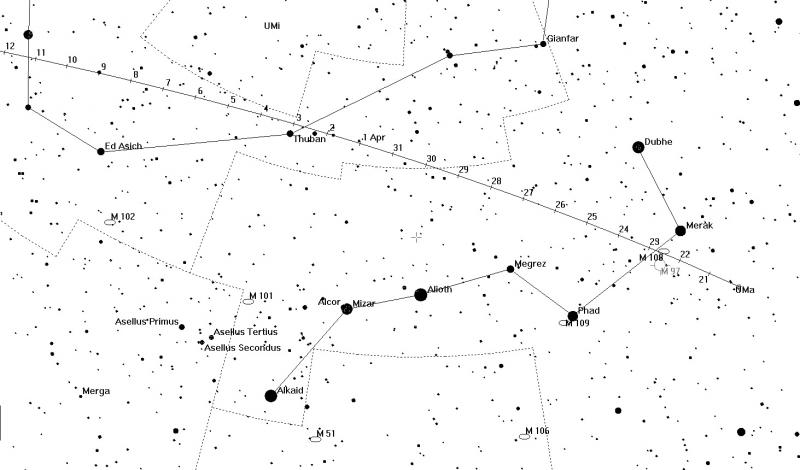
Figure 5. The track of 41P/Tuttle-Giacobini_Kresak from March 21 to April 12, heading north of the familiar Ursa Major ‘Plough’ shape.
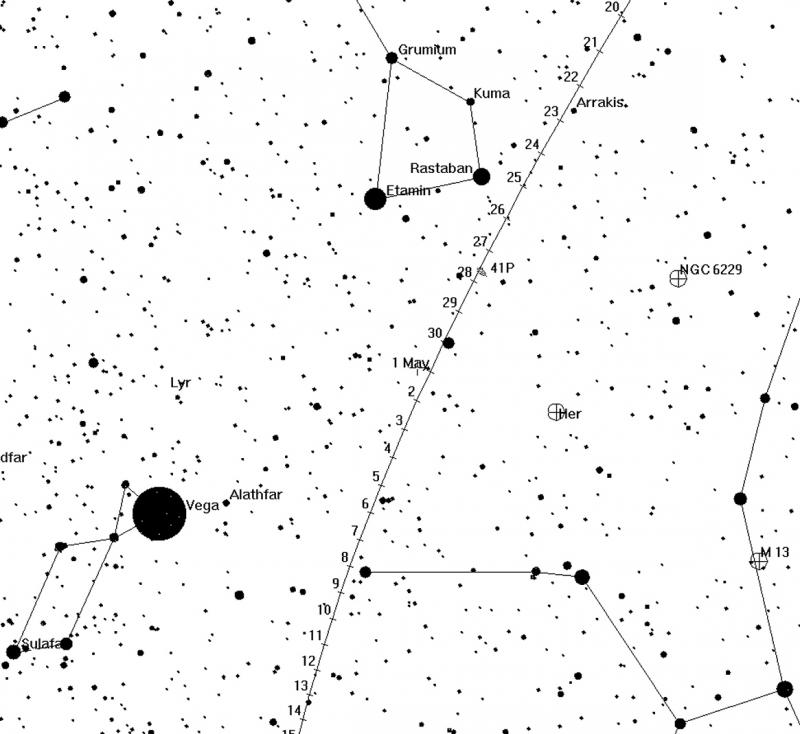
Figure 6. As April turns to May Comet 41P/Tuttle-Giacobini-Kresak plunges in altitude for UK observers as it passes from the Draco head region towards the Hercules/Lyra border region.
Comet 73P/Schwassmann-Wachmann has a very complicated history, not least because it split into multiple components 22 years ago. What will be seen of its components this year is impossible to predict. Originally discovered in 1930 by Friedrich Carl Arnold Schwassmann and Arno Arthur Wachmann of the Hamburg Observatory, it was then lost until 1979 despite having an orbital period of only 5.4 years. The comet was missed in 1985/86, but seen again in 1995, as bright as magnitude 7.5, which was when the fun started. By the end of December 1995 observers were reporting multiple components of the comet, with as many as five separate condensations. In 2001 the comet was very poorly placed, but two of the components were still observed. The apparition of 2006 was much better and the situation then became extremely complex with four main components within amateur range and more than sixty being detected by the Hubble Space Telescope. The 2011 return was not brilliant but the brightest component, C, was reported to be as bright as magnitude 12 at perihelion. We can only wait and see what will develop in 2017. Maybe nothing will be observed, or maybe component C (and others) will be within amateur telescope range. Unfortunately the comet will be very poorly placed for UK observers with the solar elongation in March (perihelion on March 17) never exceeding 46 degrees and the comet being located in Capricornus for most of the month. So if any of its component parts do perform it will primarily be a southern hemisphere object at its peak.
Comet 2015 V2 (Johnson), the only long period comet likely to be within amateur range in 2017 at the time of writing, was discovered on 2015 November 3 by Jess Johnson, while studying Sky Survey images taken with the 0.68m Catalina Schmidt. The object was then only magnitude 17, with a coma 10 to 15 arcseconds in diameter. It soon became apparent that this object could become a very well-placed binocular magnitude object, two years later, in 2017. In fact, for northern hemisphere observers, especially in the UK, it will be nicely placed at a decent altitude throughout the spring and early summer months, only sliding south and out of reach during July, when it should put on a decent display for those further south. The comet reaches perihelion on June 11 when it will be 1.63 AU from the Sun and 0.8 AU behind the Earth, with a healthy 127 degree elongation from the Sun. Keen UK observers should be able to observe this comet from January until July, and as 2015 V2 is predicted to peak at sixth magnitude, as June turns to July, this could end up being the best observed comet of 2017. From January until mid-June C/2015 V2 (Johnson) will either be in Boötes or north-western Hercules. As it plunges south during June, it passes just five degrees east of the brilliant star Arcturus on the third of the month. It finally leaves Boötes on June 13, heading into northern Virgo. Fingers crossed, C/2015 V2 (Johnson) could be a reasonable performer for all Yearbook readers, including those in the southern hemisphere, who will be able to enjoy its passage through Virgo, Hydra, Centaurus, Lupus and Norma from July to October.
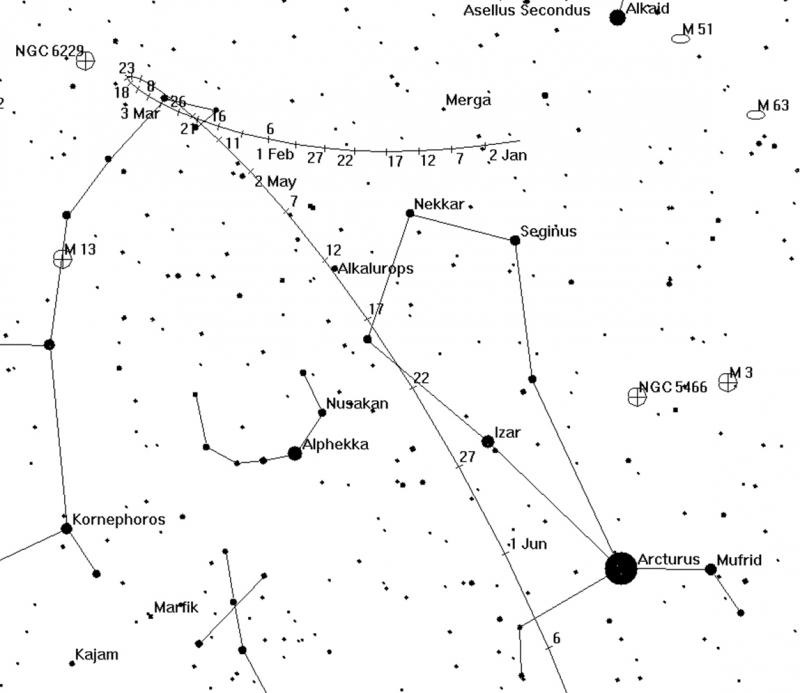
Figure 7. Comet 2015 V2 Johnson will spend the first half of 2017 in Boötes or Hercules, passing Arcturus at the start of June. The diagram shows its track from January to June.
For observers in the southern hemisphere comet 71P/Clark makes a favourable return this year, reaching opposition on June 1 and perihelion (1.58 A.U. from the Sun) on June 29. It is closest to the Earth (0.59 A.U.) on June 11 and may be an eleventh magnitude object for the entire month. Comet 71P spends the whole of June in Scorpius, not far from the head of the Scorpion and the red giant star Antares. On May 29 the comet passes slightly more than two degrees due east of that first magnitude cosmic searchlight, but even from the south coast of England the field will be low in the murk, little more than ten degrees above the southern horizon. However, for observers in, for example, Australia, the field will be virtually overhead.

Figure 8. For southern hemisphere observers comet 71P/Clark heads south through the region of the Scorpion’s head, just East of Antares, during May and June.
For southern hemisphere observers comet 213P/Van Ness reaches perihelion on September 23 and will be well-placed in Sagittarius. However, its magnitude is unlikely to be brighter than 12, so it may be more of a CCD target for amateur astronomers in the far south.
At first glance the circumstances for comet 217P/LINEAR look favourable with a perihelion date in July, a peak magnitude of 11, and a decent northern declination in Taurus. However, its small elongation from the Sun and the UK summer twilight mean it will only become observable in pre-dawn skies during September, while in Monoceros, by which time it will have faded to magnitude 14.
Any comet theoretically capable of reaching second magnitude sounds like a pretty exciting object to look out for, but 96P/Machholz achieves this feat solely because it approaches the Sun to within 0.124 A.U. on October 27; at this time its solar elongation will be less than seven degrees, so it will be unobservable, except in instruments such as the SOHO coronograph. Even so, being such an unusual periodic comet, and one discovered by an amateur astronomer, many amateurs will make an effort to view or image it before it reaches perihelion on October 27. After perihelion its solar elongation remains dire, so the approach to perihelion is the important period. Astronomers in the southern hemisphere are greatly favoured here, because 96P approaches the Sun from constellations in the extreme southern sky. In mid-August the comet, at sixteenth magnitude, will be around -80 degrees in declination and by mid-September, at fourteenth magnitude, it is still around -60. The critical period for viewing or imaging 96P from the southern hemisphere will be from late September and into the first week of October. From the latitude of Siding Spring Observatory the eleventh magnitude comet will only be eighteen degrees above the evening sunset south-western horizon, when the Sun is fifteen degrees down, namely by October 5. By October 10, for the same late twilight conditions, the comet should have brightened to magnitude 10, but will now only be twelve degrees above the horizon. These are very tricky observing conditions, but no doubt a few determined observers will get a result, or even image the comet in the weeks before, when it will be much fainter, but higher in the southern hemisphere evening sky.
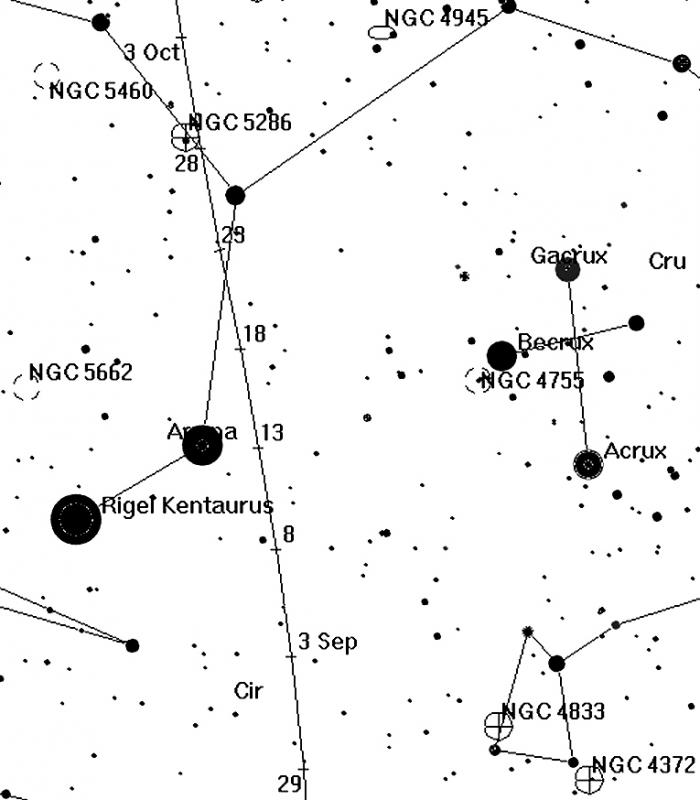
Figure 9. Comet 96P/Machholz will be thirteenth magnitude at best during September as it passes between Crux and Centaurus. However, for Southern Hemisphere observers this may be the best time to image it, before the solar elongation drops below 50 degrees.
Comets 62P/Tsuchinshan and 24P/Schaumasse have a lot in common when they return to the inner solar system this autumn. Their perihelion dates only differ by one day (November 15 and 16 respectively) and their orbital inclinations only differ by 2 degrees. They follow very similar tracks across the morning sky too, crossing the whole width of Leo in October/November and entering Virgo on November 9 (Schaumasse) and November 26 (Tsuchinshan). They both end the year close to the Virgo/Libra border too and should peak at tenth or eleventh magnitude. It could be hard not to mentally confuse the two after a freezing cold pre-dawn observing session! A plot of their tracks across the sky shows their almost parallel paths are separated by less than two degrees in declination as they cross from Cancer to Leo in October, and only one degree as they leave Leo and enter Virgo. In Right Ascension and in the time they travel across the sky their positions are notably different though, with 24P leading the way by two weeks or roughly one hour in Right Ascension. Both comets track through some very rich galaxy fields in the November and December morning skies so there will be plenty of photo opportunities where they will pass near to galaxies similar in magnitude to themselves. Comet 24P/Schaumasse will pass in front of the tenth magnitude galaxy NGC 3377 on the morning of October 26 and within arcminutes of eleventh magnitude NGC 3666 on the morning of November 4, although the Full Moon will spoil that latter encounter. On the mornings of November 10 and 11 comet 62P/Tsuchinshan will track a quarter of a degree below the well-known galaxy trio of M105, NGC 3384 and NGC 3389 while simultaneously tracking three-quarters of a degree above the even better known duo of M95 and M96. A field of view of slightly more than one degree will fit all these galaxies and the comet inside. However, glare from the nearby last-quarter Moon on both these mornings, especially on November 11, will be a big problem.
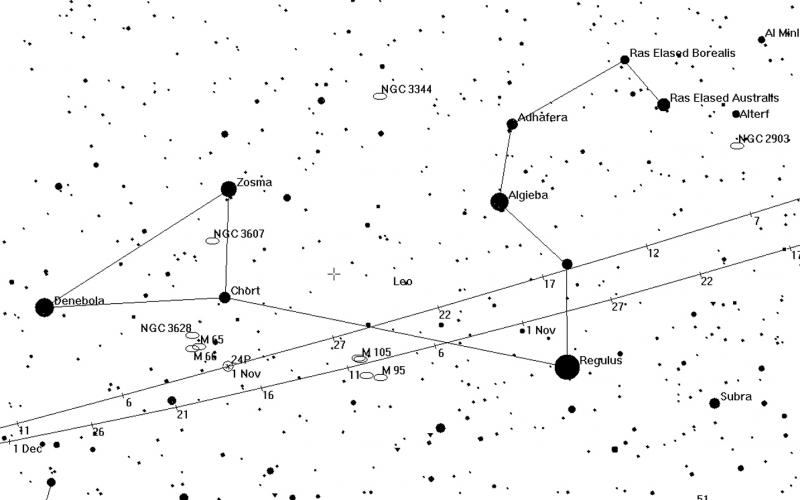
Figure 10. Comets 24P/Schaumasse (upper line) and 62P/Tsuchinshan follow parallel tracks heading east through Leo during October and November.
Of course, it goes without saying that the phase of the Moon and its proximity to the field where any comet lies has a huge bearing on the object’s visibility. Even when a comet is high up at midnight, a Full Moon ten or twenty degrees away will trash any prospects of observing it visually, so potential comet spotters need to be very aware of the position and brightness of the Moon when planning any comet observing. CCDs are much more tolerant of a bright sky and image processing can work wonders in compensating.
The Defunct Comets
By their very nature comets are highly unpredictable performers. Their nuclei come in a variety of shapes and sizes, are covered with patches of icy material on the surface, or under the surface, and they spin at various rates too. The smallest ones are highly prone to disintegration when they come close to the Sun and others can have their orbits altered drastically, now and again, by the giant planet Jupiter. Every apparition is different from the Earth-based observer’s viewpoint. The comet may arrive at perihelion with the Earth poorly placed, such as when the comet is on the opposite side of the Sun, or, conversely, the comet may pass within tens of millions of kilometres of our home planet. In addition, comets lose material every time they reach perihelion and, after thousands of orbits, a short period comet may simply have no more material to discharge. Some comets slowly fragment on each passage with more components being detected on every return. It is therefore hardly surprising that numerous comets are lost and declared ‘Defunct’, implying they have simply disappeared or broken up and will never be seen again. However, with deep CCD surveys of the night sky becoming ever more powerful and remorseless in their imaging runs some of these formerly missing comets are occasionally recovered. Modern computing power often enables an object with a slightly different orbit (often altered by the influence of giant Jupiter) to be revealed as an old comet, not seen for many decades. In 2017 at least three of these D/ category comets are predicted to return to perihelion if they still exist. In all probability they will not be recovered, but a recovery of one of them cannot be ruled out. The most interesting 2017 ‘D’ comets are arguably D/Harrington-Wilson (1952 B1), 18D/Perrine-Mrkos and, as a very unlikely returner, 5D/Brorsen.
Harrington and Wilson discovered 1952 B1 using the 122-cm Schmidt telescope at Palomar, during the course of that observatory’s Sky Survey on 1952 January 30. They estimated the magnitude as 15, and described the comet as diffuse, with a tail less than one degree long. The discoverers confirmed the comet on a subsequent plate exposed on February 4. One year after its discovery L. Kresák postulated that this comet could conceivably be the lost periodic comet Taylor of 1916. Some 27 years after its discovery Brian Marsden calculated a 6.36 year orbit for the comet, similar to other calculations by Nakano in 2002, which actually gave 6.35 years. However, the comet is still lost, although if it did come back to perihelion in February 2017 it could theoretically reach binocular magnitude.
Charles Dillon Perrine of the Lick Observatory in California discovered his comet on 1896 December 9 when it was magnitude 8. After the comet’s 1909 return the comet was not seen again until 1955, despite having an orbital period of between six and seven years. The man who re-discovered it was no less a person than Antonin Mrkos of the Skalnate Pleso Observatory, during a routine visual search for comets with giant 25×100 binoculars on 1955 October 19. It was a healthy ninth magnitude object then, so had not become inactive as had been feared. The comet was duly named 18P/Perrine-Mrkos, but has now been lost for a further sixty years, so the P designation is now a D. Clearly this is an enigmatic object which can stay dormant for decades before another surge in activity. With a period of around 6.7 years, according to the current MPC database, it could return at the end of 2016 or in early 2017. We will just have to wait and see.
Theodor Brorsen of Holstein in Germany discovered his comet on 1846 February 26, in Pisces. It was observed at the returns of 1857, 1868, 1873 and 1879, but has not been seen since, despite having an orbital period of between five and six years. It became the fifth periodic comet, named 5P/Brorsen, or rather, 5D/Brorsen in the modern era, as it is assumed to be dormant. Even with modern deep patrols it is exceedingly unlikely that 5D will be recovered in late 2016, 2017 or 2018, but comets are totally unpredictable animals, so one just never knows. As with all these defunct comets we will just have to wait and see if one of the big survey systems, like PanSTARRS, picks it up.
| The British Astronomical Association supports amateur astronomers around the UK and the rest of the world. Find out more about the BAA or join us. |
